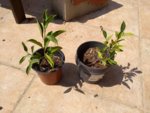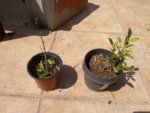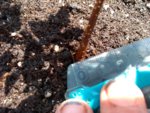Starfox
Masterpiece
OK so this has come from another thread with the general idea to see how defoliating a ficus, in this case microcarpa cuttings, will effect long term growth. For example will defoliation inhibit the growth or speed it up. Now there is plenty of reading on the webs that state a case for either and instead of citing one post or another I figure it is best to see what happens first hand. This will obviously be a long term project to see the best results but I will update the thread every now and then and hopefully don't kill the things in the process.
So to be clear I am starting off with two cuttings that were started at the same time and are of similar size and have now planted them out into larger nursery pots filled with a mix of potting mix and lava rock.
Both pots have had a handful of nutricote pellets chucked in and will get the same water and weekly/fortnightly liquid feed.
One cutting will be defoliated probably 3 times during a growing season and I will not cut any branches either.
The other will not be defoliated or cut at all.
The only caveat I will add to this is in Spring and Autumn we tend to get thrips so I will remove any affected growth on both plants when this occurs.


Both cuttings are at about 0.5 centimeters now and both will sit next to each other in the same spot.
Being mid season now I may not get another shot at defoliation this year but then again I might, I wont do it if I think there is not enough time.
So to be clear I am starting off with two cuttings that were started at the same time and are of similar size and have now planted them out into larger nursery pots filled with a mix of potting mix and lava rock.
Both pots have had a handful of nutricote pellets chucked in and will get the same water and weekly/fortnightly liquid feed.
One cutting will be defoliated probably 3 times during a growing season and I will not cut any branches either.
The other will not be defoliated or cut at all.
The only caveat I will add to this is in Spring and Autumn we tend to get thrips so I will remove any affected growth on both plants when this occurs.


Both cuttings are at about 0.5 centimeters now and both will sit next to each other in the same spot.
Being mid season now I may not get another shot at defoliation this year but then again I might, I wont do it if I think there is not enough time.
Attachments
Last edited:







